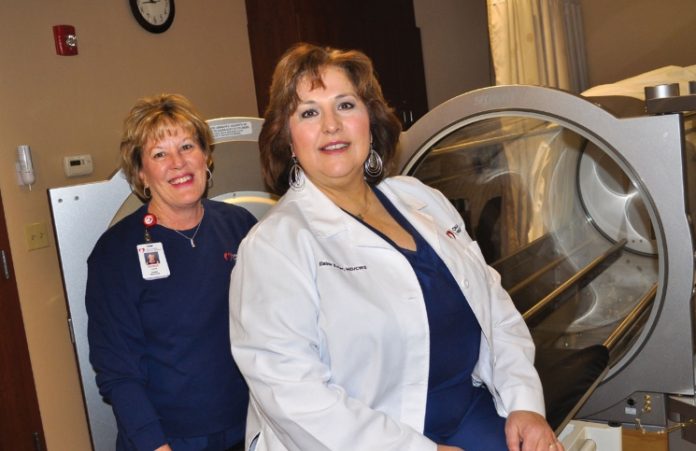by Mike Lee, Staff Writer
When it comes to wound care in Central Oklahoma, Elaine Soter, MD, CWS is a well-known commodity.
That’s why the physician-owned Oklahoma Heart Hospital decided it was high time to put Soter’s reputation and expertise to work for its vascular patients.
The Oklahoma Heart Hospital Wound Center opened for patient care earlier this month.
The new state-of-the-art facility opened its doors at 530 SW 80th Street in Oklahoma City, under the guidance of Soter, who serves as OHH Wound Center Medical Director.
The new wound center brings the community treatment and protocols to treat chronic wounds including hyperbaric oxygen therapy, negative pressure therapies, bioengineered tissues and biosynthetics. Patients may also have the opportunity to participate in clinical trials and multicenter studies.
“More than 8 million people in the U.S. suffer from chronic wounds of which healing has been impeded by such diseases and conditions as diabetes, obesity, aging and the late effects of radiation therapy,” Soter said. “With the prevalence of both diabetes and obesity in Oklahoma, specialty treatment centers like ours are a great addition to the medical landscape.”
A member of the Healogics network, the wound center employs a rigorous scientific approach to explore, test, find and develop the clinically proven methods and technologies which reintroduce the body’s innate ability to heal. The network, comprised of academic medical centers, hospitals and thousands of professionals is committed to advancing wound healing by creating, sharing, and activating wound prevention and care expertise.
Denise Caram, MHA, serves as the director of the new center. She served with Soter in the same capacity at at the Healogics clinic at Midwest Regional Medical Center.
Caram understands OHH’s draw to Soter.
“Their relationship with her is so strong that once they decided to do a wound center they wanted her,” Caram said. “They went after her and that’s a tribute.”
Soter says the new clinic is invigorating and the fact it bears the Oklahoma Heart Hospital name is exciting. “Oklahoma Heart has a stellar reputation and I already work with a good many of these physicians. It was an opportunity for us to knit that relationship more closely and access a different group of patients in need,” Soter said. “It was just an opportunity for me to align myself with an already well-known group of doctors that get it. They get what our aim is.”
Oklahoma Heart Hospital serves every county in the state of Oklahoma with more than 60 outreach centers.
Oklahoma is No. 1 in the number of amputations in the U.S.
Caram remembers the story of a patient who came from Arkansas who had originally been told his lower leg would need to be removed.
“All they had to do was take a toe,” Caram said. “I think that’s pretty impressive. We’ve just not bragged about that very much here.”
Soter knows the statistics and said it’s an education battle as it is a medical one.
“I think part of it is the traditional fatalistic attitude we have with diabetics and the belief once a diabetic’s foot starts to have trouble that there is nothing they can do and it’s a guarantee they will have an amputation,” Soter said. “And we’ve actually proven that that’s not quite true and that if you put that effort into limb salvage maybe you can reduce the level of amputation and maybe you can completely avoid it and certainly you can preserve function.
“The philosophy that is traditional if you applied it to hearts and to cancer they would never have angioplasty, bypass or chemo and I like to think what we do is very much like that.”
Many patients treated for problematic wounds may be candidates for hyperbaric oxygen therapy, a treatment in which the patient breathes 100 percent oxygen inside a pressurized chamber for short periods of time. This therapy can be beneficial for treating wounds that are difficult to heal.
Chronic wounds affect millions of people in the U.S. and the incidence is rising, fueled by an aging population and increasing rates of diseases and conditions such as diabetes, obesity, and the late effects of radiation therapy.
Untreated, chronic wounds can lead to diminished quality of life and possibly amputation of the affected limb.
Two nurses will work the clinic with plans to add another.
The center is run by Healogics, the nation’s largest provider of advanced wound care services.
Using an evidence-based systematic approach to chronic wound healing, Healogics provides specialty wound care for an underserved and growing patient population through its 500 wound care centers.
Nearly 200,000 patients per year are seen through a connected network of centers, partner hospitals, academic medical centers, patients and families.












